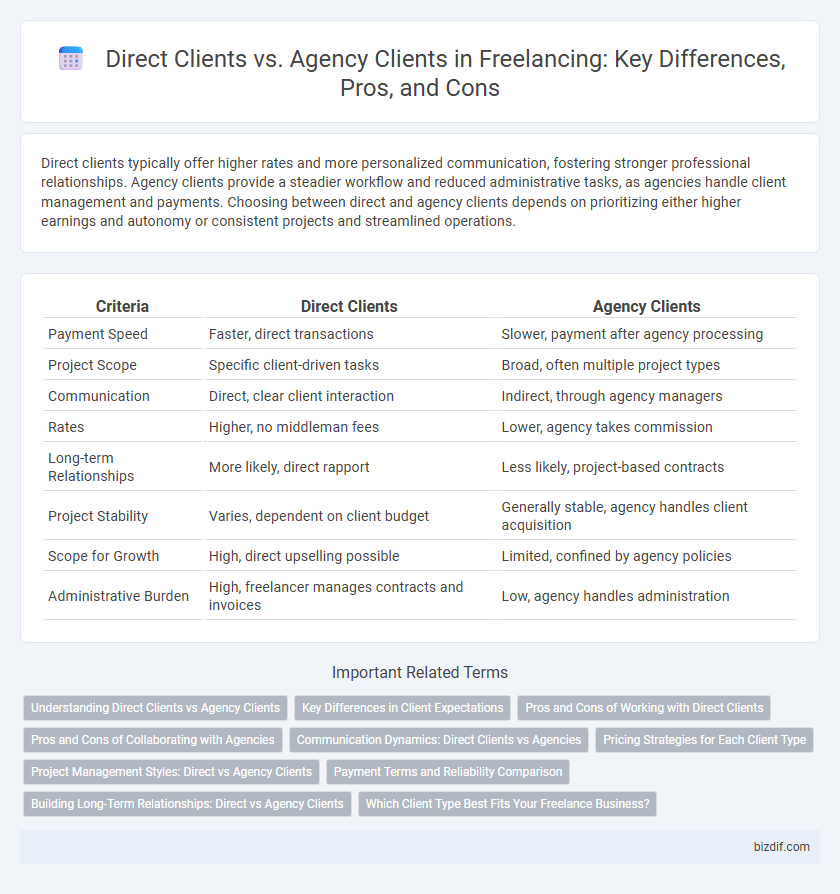Direct clients typically offer higher rates and more personalized communication, fostering stronger professional relationships. Agency clients provide a steadier workflow and reduced administrative tasks, as agencies handle client management and payments. Choosing between direct and agency clients depends on prioritizing either higher earnings and autonomy or consistent projects and streamlined operations.
Table of Comparison
| Criteria | Direct Clients | Agency Clients |
|---|---|---|
| Payment Speed | Faster, direct transactions | Slower, payment after agency processing |
| Project Scope | Specific client-driven tasks | Broad, often multiple project types |
| Communication | Direct, clear client interaction | Indirect, through agency managers |
| Rates | Higher, no middleman fees | Lower, agency takes commission |
| Long-term Relationships | More likely, direct rapport | Less likely, project-based contracts |
| Project Stability | Varies, dependent on client budget | Generally stable, agency handles client acquisition |
| Scope for Growth | High, direct upselling possible | Limited, confined by agency policies |
| Administrative Burden | High, freelancer manages contracts and invoices | Low, agency handles administration |
Understanding Direct Clients vs Agency Clients
Direct clients offer freelancers streamlined communication and often higher pay rates since there are no intermediaries, leading to clearer project expectations and faster feedback loops. Agency clients provide a steady volume of work and diverse projects by acting as intermediaries between freelancers and larger corporations, but they may reduce earnings due to commission fees. Understanding these differences helps freelancers tailor their business strategies for consistent income and optimal workload management.
Key Differences in Client Expectations
Direct clients typically expect personalized communication, faster turnaround times, and tailored solutions that directly address their unique business needs. Agency clients often require adherence to strict project guidelines, standardized processes, and scalability to fit broader campaign strategies or multiple client demands. Understanding these differences helps freelancers optimize client satisfaction and project management approaches for each type.
Pros and Cons of Working with Direct Clients
Working with direct clients offers freelancers higher profit margins by eliminating agency fees and fosters stronger communication, leading to clearer project expectations and personalized feedback. However, managing direct clients requires handling all administrative tasks, including contracts and payments, which can be time-consuming and potentially challenging without the support structure agencies provide. Building a client base independently demands significant effort in marketing and networking but allows greater control over project selection and pricing.
Pros and Cons of Collaborating with Agencies
Collaborating with agencies often ensures a steady workflow and access to larger projects, as they provide consistent client referrals and handle project management, reducing the freelancer's administrative burden. However, agencies typically charge a commission or fees that decrease overall earnings, and the freelancer may have less creative control or direct communication with the end client. Freelancers working with agencies benefit from brand credibility and structured contracts but must navigate potential delays in payment and less flexibility in project scope.
Communication Dynamics: Direct Clients vs Agencies
Direct clients offer streamlined communication with fewer intermediaries, enabling faster project feedback and clearer expectations. Agencies often involve multiple stakeholders, which can complicate communication and require more detailed status updates to align all parties. Efficient communication dynamics directly influence project timelines and client satisfaction in freelancing.
Pricing Strategies for Each Client Type
Direct clients typically offer higher payment rates due to the absence of intermediary fees, allowing freelancers to set personalized pricing strategies based on project scope and client budget. Agency clients often require competitive, standardized pricing models as agencies allocate fixed budgets across multiple freelancers, emphasizing cost-effectiveness and quick turnaround. Tailoring pricing strategies involves balancing premium rates for direct clients with volume-based or retainer pricing structures favored by agencies to ensure steady workflow and income stability.
Project Management Styles: Direct vs Agency Clients
Direct clients often prefer a personalized project management style with clear communication and flexible timelines, allowing freelancers to tailor their workflow to specific needs. Agency clients typically require adherence to structured processes, including detailed reporting, milestone tracking, and multiple stakeholder approvals to align with their internal protocols. Managing direct clients demands adaptability and responsiveness, while agency clients necessitate consistency and strict project documentation.
Payment Terms and Reliability Comparison
Direct clients often provide more favorable payment terms, including faster payouts and upfront deposits, enhancing cash flow reliability for freelancers. Agency clients typically operate on fixed payment schedules with delays due to intermediary processing, which can affect timely compensation. Freelancers working with direct clients benefit from transparent communication and contractual clarity, reducing payment disputes and increasing overall payment assurance.
Building Long-Term Relationships: Direct vs Agency Clients
Building long-term relationships with direct clients often results in better communication, personalized project understanding, and higher trust, fostering consistent freelance work and repeat business. Agency clients may offer more volume but typically involve less personal interaction, creating challenges in relationship depth and loyalty. Prioritizing direct client relationships can enhance career stability and lead to more lucrative contracts over time.
Which Client Type Best Fits Your Freelance Business?
Direct clients often provide clearer communication, higher project control, and better profit margins, making them ideal for freelancers seeking long-term relationships and personalized collaboration. Agency clients offer consistent workflow, diverse project opportunities, and reduced administrative tasks, suitable for freelancers prioritizing steady income and varied experience. Evaluating your business goals, preferred workload, and communication style helps determine which client type best fits your freelance business.
Direct clients vs Agency clients Infographic

 bizdif.com
bizdif.com